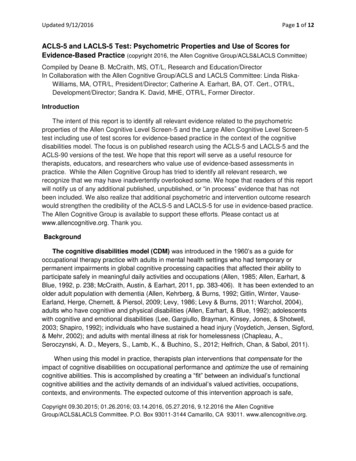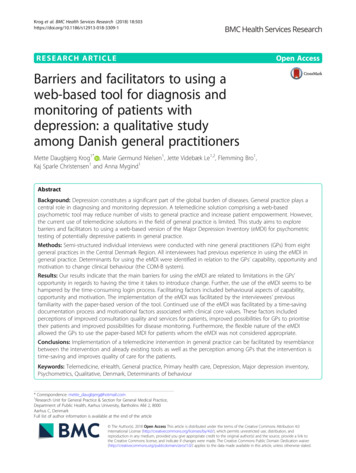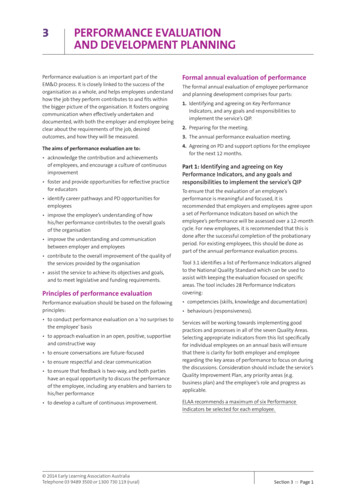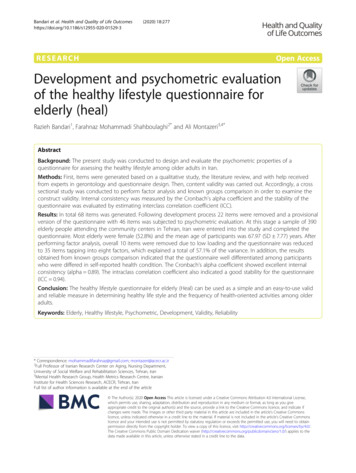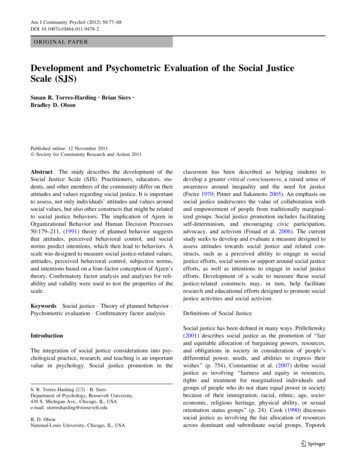
Transcription
Am J Community Psychol (2012) 50:77–88DOI 10.1007/s10464-011-9478-2ORIGINAL PAPERDevelopment and Psychometric Evaluation of the Social JusticeScale (SJS)Susan R. Torres-Harding Brian SiersBradley D. Olson Published online: 12 November 2011Ó Society for Community Research and Action 2011Abstract The study describes the development of theSocial Justice Scale (SJS). Practitioners, educators, students, and other members of the community differ on theirattitudes and values regarding social justice. It is importantto assess, not only individuals’ attitudes and values aroundsocial values, but also other constructs that might be relatedto social justice behaviors. The implication of Ajzen inOrganizational Behavior and Human Decision Processes50:179–211, (1991) theory of planned behavior suggeststhat attitudes, perceived behavioral control, and socialnorms predict intentions, which then lead to behaviors. Ascale was designed to measure social justice-related values,attitudes, perceived behavioral control, subjective norms,and intentions based on a four-factor conception of Ajzen’stheory. Confirmatory factor analysis and analyses for reliability and validity were used to test the properties of thescale.Keywords Social justice Theory of planned behavior Psychometric evaluation Confirmatory factor analysisIntroductionThe integration of social justice considerations into psychological practice, research, and teaching is an importantvalue in psychology. Social justice promotion in theS. R. Torres-Harding (&) B. SiersDepartment of Psychology, Roosevelt University,430 S. Michigan Ave., Chicago, IL, USAe-mail: storresharding@roosevelt.eduB. D. OlsonNational-Louis University, Chicago, IL, USAclassroom has been described as helping students todevelop a greater critical consciousness, a raised sense ofawareness around inequality and the need for justice(Freire 1970; Pitner and Sakamoto 2005). An emphasis onsocial justice underscores the value of collaboration withand empowerment of people from traditionally marginalized groups. Social justice promotion includes facilitatingself-determinism, and encouraging civic participation,advocacy, and activism (Fouad et al. 2006). The currentstudy seeks to develop and evaluate a measure designed toassess attitudes towards social justice and related constructs, such as a perceived ability to engage in socialjustice efforts, social norms or support around social justiceefforts, as well as intentions to engage in social justiceefforts. Development of a scale to measure these socialjustice-related constructs may, in turn, help facilitateresearch and educational efforts designed to promote socialjustice activities and social activism.Definitions of Social JusticeSocial justice has been defined in many ways. Prilleltensky(2001) describes social justice as the promotion of ‘‘fairand equitable allocation of bargaining powers, resources,and obligations in society in consideration of people’sdifferential power, needs, and abilities to express theirwishes’’ (p. 754). Constantine et al. (2007) define socialjustice as involving ‘‘fairness and equity in resources,rights and treatment for marginalized individuals andgroups of people who do not share equal power in societybecause of their immigration, racial, ethnic, age, socioeconomic, religious heritage, physical ability, or sexualorientation status groups’’ (p. 24). Cook (1990) discussessocial justice as involving the fair allocation of resourcesacross dominant and subordinate social groups. Toporek123
78and Williams (2006) define social justice as a process ofengaging individuals as co-participants in decision-makingthat eventually leads to action. They propose that professionals should actively engage in advocacy, empowerment,and social action within the community. Finally, Fouadet al. (2006) describe social justice as ensuring thatopportunities and resources are fairly distributed withinsociety, and that individuals and groups work towardensuring equity when these resources are not fairlydistributed.In all of these definitions, social justice is consistentlydescribed as a value or belief, encompassing the idea thatpeople should have equitable access to resources andprotection of human rights. In addition, definitions of socialjustice typically involve power. Each definition encompasses the idea that structural and social inequalities shouldbe minimized, and that society should work towardempowerment with people from disadvantaged or disempowered groups. Thus, participation, collaboration, andempowerment are all key components of social justicework. Social justice is a fundamental value of the community psychology field, particularly due to its emphasison eliminating oppressive social conditions and promotingwellness (Prilleltensky 2001).Social Justice in ActionWhat does social justice look like in practice? Social justice promotion involves actively changing institutions,policies, and economic or governmental structures thatperpetuate harmful or unfair practices, which eventuallyrestrict access to resources (Fouad et al. 2006). Withincommunity psychology, social justice values are foundations of activities such as advocacy, analyzing public policy, community organizing, and political activism(Prilleltensky and Nelson 2002). Likewise, communitypsychology practices of collaboration and power sharingwith community members and community organizationsare utilized precisely because they minimize existingpower differentials and are viewed as inherently empowering. Becoming more knowledgeable about oppressionand sociocultural contexts, engaging in ongoing selfexamination around issues of power and privilege, andconducting preventative and transformative interventionsare key skills for community interventionists (Prilleltenskyand Nelson 2002).Social justice work also involves changing the regularities of a system, or the way things are typically done. Thismight involve re-conceptualizing problems from an ahistorical and asocial perspective to understanding an individual in context (Sarason 1981). It may also involveconfronting an authority figure who represents power, orputting fair organizational practices into place, or working123Am J Community Psychol (2012) 50:77–88to prevent the harm that arises from standard organizationalinterventions or policies (Prilleltensky and Nelson 2002).Socially just clinical practice includes challenging harmfultherapeutic techniques, possessing information aboutindigenous models of health and healing, decreasingdependency of clients and community members, and supporting individual and community strengths (Constantineet al. 2007; Fouad et al. 2006; Goodman et al. 2004;Prilleltensky and Nelson 2002).Increasing awareness and skill training are both important to the promotion of social justice. However, awarenessof social justice, while necessary, may not be sufficient tomotivate real change efforts. Changing social justice-related behaviors may entail more than simply changing attitudes (Cook 1990; Fox 2003). More research is neededexamining the impact that educational efforts and skilldevelopment may have on social justice-related practices(Pitner and Sakamoto 2005; Watts 2004). Researchers whohave studied social activism have found that attitudes andbeliefs are key elements of a greater ‘activist’ orientation.For example, Liss et al. (2004) found that feministcollective activism was predicted by one’s beliefs, one’sself-labeling as a feminist, and belief in collective action.Acceptance of social justice ideals is a critical step towardsfacilitating students’ engagement in social action (Goodman 2000), but the ultimate purpose of social justiceeducation is to encourage social action. The link betweenattitudes and social action warrants more empirical investigation. To this end, it is important to develop measures that will allow researchers and educators to morefully understand the process of moving from attitudes toaction.Linking Social Justice to ActionAjzen (1991) presents a social cognitive model that provides a useful framework to consider how attitudes andrelated constructs might predict social justice relatedbehaviors. Ajzen’s theory of planned behavior has beenapplied successfully to a range of health-related behaviors,such as increasing levels of exercise, frequency of testicularor breast self-examinations, regulation of eating/nutrition,safe driving behaviors, and volunteerism (Hardeman et al.2002). Ajzen’s model was developed to link attitudes withbehaviors. The central tenet of this theory is that behavioralperformance is best directly predicted by one’s statedintention to act (Fig. 1). In turn, one’s intentions to act arepredicted by one’s attitudes towards the action, subjectivenorms around the action, and one’s perceived behavioralcontrol of the action. To date, Ajzen’s model has not beenapplied to social justice, and no scale has been developed tomeasure variables that might predict behavioral performance of social justice-related activities. However, this
Am J Community Psychol (2012) 50:77–8879Measurement of Social Justice Attitudes and BehaviorsFig. 1 Ajzen (1991) theory of planned behaviormodel might serve as a particularly relevant framework thatexplains how attitudes towards social justice might eventually predict social justice-related behaviors.Ajzen (1991) describes attitudes as involving generaldispositions towards a given behavior. In the case ofsocial justice, it would involve an individual’s acceptance of the social justice ideals and related values, suchas the belief that one should act for social justice, orthat it is right or fair to promote equality of opportunityfor everyone, regardless of background. In this model,one’s attitudes around social justice would be animportant predictor of one’s intentions to act for socialjustice.Ajzen describes perceived behavioral control as one’sperceived ability to perform an act. In a social justicecontext, this might involve the extent to which a personfeels it is possible to ‘make a difference’, or the selfevaluation of whether one can have an impact on existingsocial conditions. Ajzen notes that perceived behavioralcontrol would directly predict intentions to act, and, insome cases, might also directly predict behavioral performance itself if the action itself was particularly difficult or challenging. Thus, beliefs in the ability to act forsocial justice should predict intentions to act. In addition,many of the social justice-promoting actions describedcould be viewed as particularly difficult or challengingbecause it involves changing the status quo (Prilleltenskyand Nelson 2002). Thus, perceived behavioral control islikely to directly impact behavioral performance itself, inaddition to one’s stated intentions to work for socialjustice.Ajzen hypothesized that a final component of his model,subjective norms, also predicts intentions to act. Subjectivenorms are described as the support, or lack thereof, provided in an environment for performing a given behavior.The inclusion of subjective norms describes a mechanismby which the social context can influence the occurrence ofa behavior (Ajzen 1991). Thus, it might be expected that, insocial justice work, contextual messages, norms, and support would facilitate one’s intentions to act for socialjustice.To date, few scales have been developed to specificallymeasure these components of social justice work. Whilemany studies have examined predictors of activism withinspecific social issues, such as environmental activism (i.e.Dono et al. 2010) or feminist activism (i.e. Downing andRoush 1985), few scales have been developed to measuregeneral propensities towards activism or social justice thatgeneralize across a range of justice-related topics (Corningand Myers 2002). Several scales have been developed tospecifically measure aspects of political engagement orpolitical self-efficacy, which refers to the degree to whichindividuals believe they have the capacity to affect thepolitical process (Caprara et al. 2009). Corning and Myers(2002) developed the Activism Orientation Scale to measure an individual’s propensity to engage in a range ofactivist behaviors, including high—risk and conventionalactivism. However, activism is just one component ofsocial justice work.Researchers have also developed scales to measure howpeople judge the fairness of societal conditions by applyingprinciples of distributive and procedural justice. Forexample, Rasinski (1987) scale measures the degree towhich people use principles of proportionality (equality ofopportunities) or egalitarianism (equality of outcomes) inmaking judgments of fairness as they apply to society.Other scales have been developed to assess the perceptionsof fairness in specific contexts, such as the OrganizationalJustice scale (Colquitt 2001).Some researchers have developed scales that specificallyexamine the extent to which psychologists themselvesvalue and engage in social justice related behaviors.Ritchhart (2002) developed the Psychologists’ Beliefs inSocial Justice Scale to measure psychologists’ attitudestowards social justice and social activism in their professional roles. Similarly, Dean (2009) developed the SocialJustice Advocacy Scale to measure the degree to whichcounselors engage in collaborative action, social/politicaladvocacy, client empowerment, and client/communityadvocacy in the context of a therapeutic relationship. Thesescales, however, are specifically limited to the social justicework within mental health practice, and may not beapplicable to non-clinicians.To date, only one scale (Miller et al. 2009), the SocialIssues Questionnaire, has specifically used a career-orientation framework to understand the social cognitive processes whereby individuals are likely to work for socialjustice. This recent work has examined how students mightdevelop interests in and, ultimately, a commitment to,social justice. The social cognitive career theory used asthe underlying theoretical framework was originallydeveloped to predict career choice, interests, and goal123
80attainment. Their scale measured several components ofthis process, including self-efficacy, outcome expectations,interest, supports, barriers, and commitment.Information obtained from these measures has importantimplications for a person’s views towards social justice.However, these scales do not measure general propensitiesor attitudes towards social justice that might impact one’sintentions to work for social justice through such routes asactivism, career choice, and collective social action. TheSocial Justice Scale (SJS) was developed to measure attitudes towards social justice and social justice related values, perceived self-efficacy around social justice efforts,social norms around social justice efforts, and intentions toengage in social justice related activities and behaviors.This study will examine the reliability and validityof this scale. The Social Justice Scale was specificallydeveloped as a tool to be used by community psychologiststo measure favorable attitudes toward intentions to engagein social action. Social action could include political andsocial activism, or other social justice-related activities,such as working toward empowerment through one’scareer or volunteer work, by working to change policiesthat will serve to empower others, or by talking to othersabout the need to empower people from disadvantagedgroups.To examine the convergent and discriminant validity ofthe scale, measures assessing belief-in-a-just-world, racistattitudes, sexist attitudes, and motivation to perform publicservice were also administered. We hypothesized thatindividuals who have more favorable social justice-relatedattitudes and intentions would be less likely to believe thatthe world is a just or fair place. People who endorse a ‘justworld’ ideology believe that people generally get what theydeserve in life, and, thus, may be more likely to blamepeople from disadvantaged backgrounds for their problemsand be less willing to provide help (Lipkus 1991; Pitnerand Sakamoto 2005). Similarly, people believe in a ‘justworld’ see life as essentially fair and therefore tend to beless likely to acknowledge that societal inequalities exist(Lipkus 1991). We also hypothesized that people whoexpress more racist or sexist attitudes might express lessfavorable social justice-related attitudes and intentionsbecause they view these groups as less deserving of socialjustice (Cook 1990). We hypothesized that people whohave favorable attitudes towards social justice may alsoindicate a greater willingness to engage in public service,as suggested by Ngai (2006). Finally, we expected thatindividuals who expressed more favorable attitudestowards social justice activities would be more likely toidentify as a social activist (Liss et al. 2004), and be morelikely to have engaged in social justice activities or socialaction, as suggested by Ajzen (1991) model. To the extentto which the scale is valid and reliable, it may be used in123Am J Community Psychol (2012) 50:77–88subsequent research to predict the occurrence of socialjustice-related behaviors and social activism.MethodsProcedureThe social justice attitudes scale items were administeredto undergraduates and graduate students. Students wererecruited from undergraduate and graduate classes. Students read and signed an informed consent form and thencompleted the measures, which took approximately20–30 min. All procedures were reviewed and approved bythe Roosevelt University Institutional Review Board. Thedata were collected in two waves. The sample in wave 1included 115 undergraduates and graduate students. Thesample in wave 2 included 276 graduate and undergraduates students.ParticipantsDuring wave 1, 26% of the sample of 115 individuals weremale and 74% were female. Regarding ethnicity, 50% wereEuropean American, 12% African American, 10% Latino,8%, Asian Americans, 6% Middle Eastern, and 5% multiracial (with 9% of students not indicating their ethnicity).Three percent of the first sample identified as having adisability.In order to validate the factor structure of the scale andfurther test the scale reliability and validity an additional276 students were recruited for the second phase of thestudy. This second sample was 18% male and 82% female.Regarding ethnicity, 51% were European American, 21%African-American, 10% Latino, 6% Asian-American, 2%Middle-Eastern, 4% multiracial, and 6% did not specifytheir race/ethnicity. Six percent of the second samplereported having a disability.MeasuresSocial Justice Scale (SJS)The 44 original items of the SJS were developed by a teamof researchers and graduate students specifically for thisstudy. Items were generated by this team using literaturethat described both the definition and application of socialjustice, as defined by Prilleltensky (2001); Constantineet al. (2007); Toporek and Williams (2006), and Fouadet al. (2006). Key components of the definition of socialjustice and social justice-related behaviors were integratedinto these questions, and these included: empowerment ofpeople from disadvantaged groups, the need to minimize
Am J Community Psychol (2012) 50:77–88power differentials and work collaboratively with others,helping others to access community or societal resources,the need to acknowledge existing societal inequalities thatmay be harmful, the importance of making society morefair for all people, and the belief that one should work forsocial justice.Items were generated by members of the research teamin order to fit both the definitions of social justice presentedabove and the specific components of Ajzen’s model. Afteritem generation, the scale was reviewed by a panel ofpsychologists and graduate students to assess face validity,comprehension, relevance to social justice goals and thedomains in the Ajzen (1991) model. Feedback regardingthe meaning of the items, clarity of written expression, andwhether the items appeared to assess components of socialjustice-related values, was obtained. As a result of thisprocess, 44 items measuring aspects of social justice weredeveloped. Items were answered on a 1–7 Likert type scale,with 1 disagree strongly, 4 neutral, and 7 stronglyagree.SJS Subscale 1: Attitudes Towards Social Justice Twentyitems were developed to specifically elicit endorsement ofsocial justice values, goals and behaviors. Items weredeveloped to assess attitudes towards social justice, socialjustice-related values, and social justice-related behaviors,including empowerment, collaboration, power-sharing,self-determination, and facilitating access to resources forall. Examples of these items included ‘I believe it isimportant to try to change larger social conditions thatcause individual suffering and impede well-being’, ‘Ibelieve it is important to allow others to have meaningfulinput into decisions affecting their lives’, and ‘I believe it isimportant to act for social justice.’SJS Subscale 2: Perceived Behavioral Control Fourteenitems assessing perceived behavioral control specificallyreferenced the social justice related goals rather thansimply general self-efficacy. Examples of these itemsincluded ‘I am certain that I possess an ability to work withindividuals and groups in ways that are empowering,’ I amcertain that if I try, I can have a positive impact on mycommunity, and ‘If I engage in activities to promote socialjustice, it will not make a difference.’SJS Subscale 3: Subjective Norms Six items weredeveloped to measure subjective norms around social justice concerns. These items were designed to assess whetherpeople in the respondents’ social context supported ordiscouraged engagement in social justice-related activities.Examples of these items included ‘Other people around meare engaged in activities that address social justice issues,’‘Other people around me are supportive of efforts that81promote social justice,’ and ‘Other people around me areaware of issues of social injustices and power inequalitiesin our society.’ For these items, the influence of media orother environmental influences were not assessed, as thefocus was on the general attitudes of people in therespondents’ immediate environment.SJS subscale 4: Behavioral Intentions A set of four itemsexamined behavioral intentions to engage in social actionor social justice-related activities. These included statements that the individual planned to engage in social justice-related behaviors in the future. Examples of theseitems included, ‘In the future, I intend to talk with othersabout social power inequalities, social injustices, and theimpact of social forces on health and well-being,’ and ‘Inthe future, I intend to engage in activities that will promotesocial justice.’Global Belief in a Just WorldThis is a 7-item scale that measures belief in a just world,an attributional process whereby one perceives that othersget what they deserve in life, and that, generally, people areresponsible for their own good fortune or misfortune(Lipkus 1991). The possible range of scores is between 7and 42. The Cronbach’s alpha for the scale was .83, indicating a high level of internal consistency among the scaleitems. Further, this scale demonstrated good convergentvalidity, as the total GBJWS scores were positively associated with internal locus of control, higher trust in institutions, overall trust, and higher perceived sincerity inothers (Lipkus 1991).Perry Public Service Motivation Scale—Abridged VersionThe Perry Public Service Motivation scale (Perry 1996;Coursey and Pandey 2007) was developed to measure theextent to which one might be motivated towards a careerin public service or as an employee at a public institutionor organization. Coursey and Pandey (2007) tested anabridged version of this scale comprising 10 items,derived from Perry’s (1996) original scale. This shortenedscale included 3 items from the policy subscale, 4 itemsfrom the commitment to public service/civic duty subscale, and 3 items from the compassion subscale. Perry’soriginal scale had adequate reliability, with .90 for the24-item scale, and .69 to .74 for the original four subscales. Using confirmatory factor analysis, Coursey andPandey (2007) found evidence of good fit for the revised10-item, three factor model, with a root mean squarederror of approximation (RMSEA) below .10, and adjustedgoodness of fit index (AGFI) and goodness of fit index(GFI) values above .90.123
82Symbolic Racism Scale (Henry and Sears 2002)The Symbolic Racism Scale measured subtle forms of racism expressed against African Americans. Symbolic racisminvolves the attitude that racial discrimination is no longer aproblem today, and that African Americans’ continuingdisadvantages result from their failure to take responsibilityfor their own lives (Henry and Sears 2002). This scaleencompassed eight items measured on a 1–4 anchored scale,and these items are summed to arrive at a total score. Henryand Sears (2002) reported adequate reliability. Across fiveseparate investigations, internal consistencies, as measuredby Cronbach alphas, were generally acceptable and rangedfrom a .59–.79, with four of the five investigationsreporting alphas of .70 or higher.Neosexism Scale (Tougas et al. 1995)The Neosexism Scale measured the degree to which aparticipant endorses neosexist beliefs, defined by the extentone denies the existence of gender inequalities whilesimultaneously blaming or resenting women. This scaleencompassed 11 items answered on a 1–7 scale. Theappropriateness of the scale might be of concern because itdoesn’t measure key components of sexism, such asambivalent or benevolent sexism. However, the concept of‘neosexism’ includes the idea of victim-blaming, wherebywomen are blamed for their own problems and lack ofoccupational advancement. In addition, ‘neosexism’includes a component whereby those who score high tendto minimize the existence of social inequalities between thesexes. For this reason, the neosexism construct was used asa test of discirminant validity for the current study’s definition of social justice. The scale was found to have goodoverall reliability as a unitary dimension with an alpha of.78, and a test–retest reliability of .84 (Tougas et al. 1995).Demographic QuestionsAge, race, gender, and disability level were assessed as partof the questionnaire. Participants were also asked what theyhad ever done to anything to work for social justice, and toindicate whether they self-identified as an ‘activist.’ResultsPreliminary Analyses and Revision of the ScaleInternal ConsistencyThe reliability and factor structure of the scale was firsttested in sample 1. A Cronbach’s alpha was computed for123Am J Community Psychol (2012) 50:77–88the entire 44-item scale for sample 1, a .93. In addition,separate alphas for each proposed factor in this first samplewere computed: (a) attitudes a .89, (b) subjectivenorms .85, (c) perceived behavioral control .77, and(d) intentions .86. The individual subscales were moderately correlated, from .29 (behavioral intentions andsubjective norms) to .56 (attitudes and perceived behavioral control). The corrected item-total correlations rangedfrom .18 to .69.Confirmatory Factor AnalysisNext, using LISERL (Jöreskob and Sörbom 1996), a confirmatory factor analysis was conducted with the first waveof data collected from 115 respondents. The purpose, asrecommended by Bentler and Bonett (1980), was todetermine the fit of the four-factor conceptualization of thescale. The fit of the hypothesized four-factor model (v2(896) 1,854.99, p .00) was compared to a singlelatent factor model (v2 (902) 2,330.29, p .00). Statistically significant change was found in the Chi-squarestatistic (D v2 455, D df 6, p \ .05), indicating thatthe four factor model better reproduced the observedcovariance matrix than the undimensional model.Scale RevisionAfter determining comparative fit, items with a factorloading below .50 were eliminated from the scale. Modification indices were examined to assess whether itemsloaded primarily onto their respective hypothesized factoror onto another factor. If an item loaded more strongly ontoa factor other than the hypothesized factor or loadedstrongly onto multiple factors (at a level of 7.0 or higher onthe modification indices), the item was eliminated. Thecombined result of these analyses involved dropping items27, 31, 33, 37, 38, and 42 from factor 1. From factor 2, onlyitem 15 was eliminated. From factor 3, item 36 waseliminated. No items were eliminated from factor 4.Confirmatory Factor Analyses with Revised ModelNext, the confirmatory factor analysis was re-run with therevised four factor 29–item model. The absolute fit goodness of fit indices evidenced good fit for the revised modelin the first sample. The revised four-factor model developed in the first sample was also tested in the secondsample (n 262), again using confirmatory factor analysis. The results once again showed a very good fit to themodel (v2 740.54, df 371, p 0.00; RMSEA .06).Yet, examination of the standardized estimates for theitems showed several non-significant estimates, specificallyitems 20, 24, 28, 29, and 35, indicating a potential
Am J Community Psychol (2012) 50:77–8883Table 1 Confirmatory factor analyses fit indices in sample 1 andsample 2v2Root mean squared errorof approximation(RMSEA)Sample 1(n 115)Sample 2(n 262)728.65 (df 371)a789.14 (df 246)a.08.09Normed fit index (NFI).87.95Comparative fit index(CFI).94.97Goodness of fit (GFI).65.80Adjusted goodness of fitindex (AGFI).66.75Parsimony goodness of fitindex (PGFI).60.65ap-value equal to .00misspecification of the model. When these items wereeliminated and the analysis re-run, the new model showedan acceptable level of fit (v2 789.14, df 246,p 0.00; RMSEA .09). The RMSEA for the secondanalysis was .09, slightly above the .08 value specified
Department of Psychology, Roosevelt University, 430 S. Michigan Ave., Chicago, IL, USA e-mail: storresharding@roosevelt.edu B. D. Olson . Socially just clinical practice includes challenging harmful therapeutic techniques, possessing information about indigenous models of health and healing, decreasing

